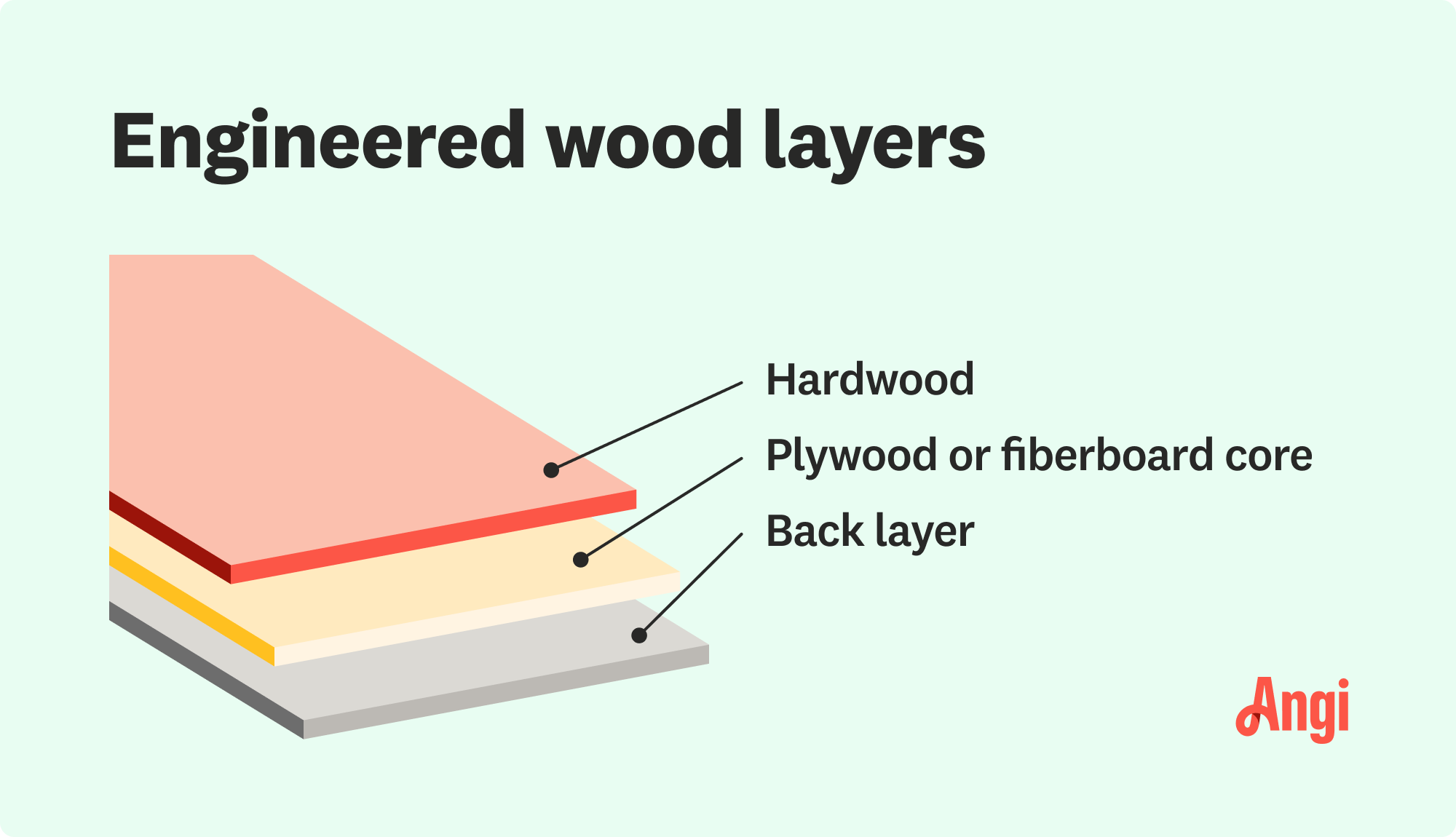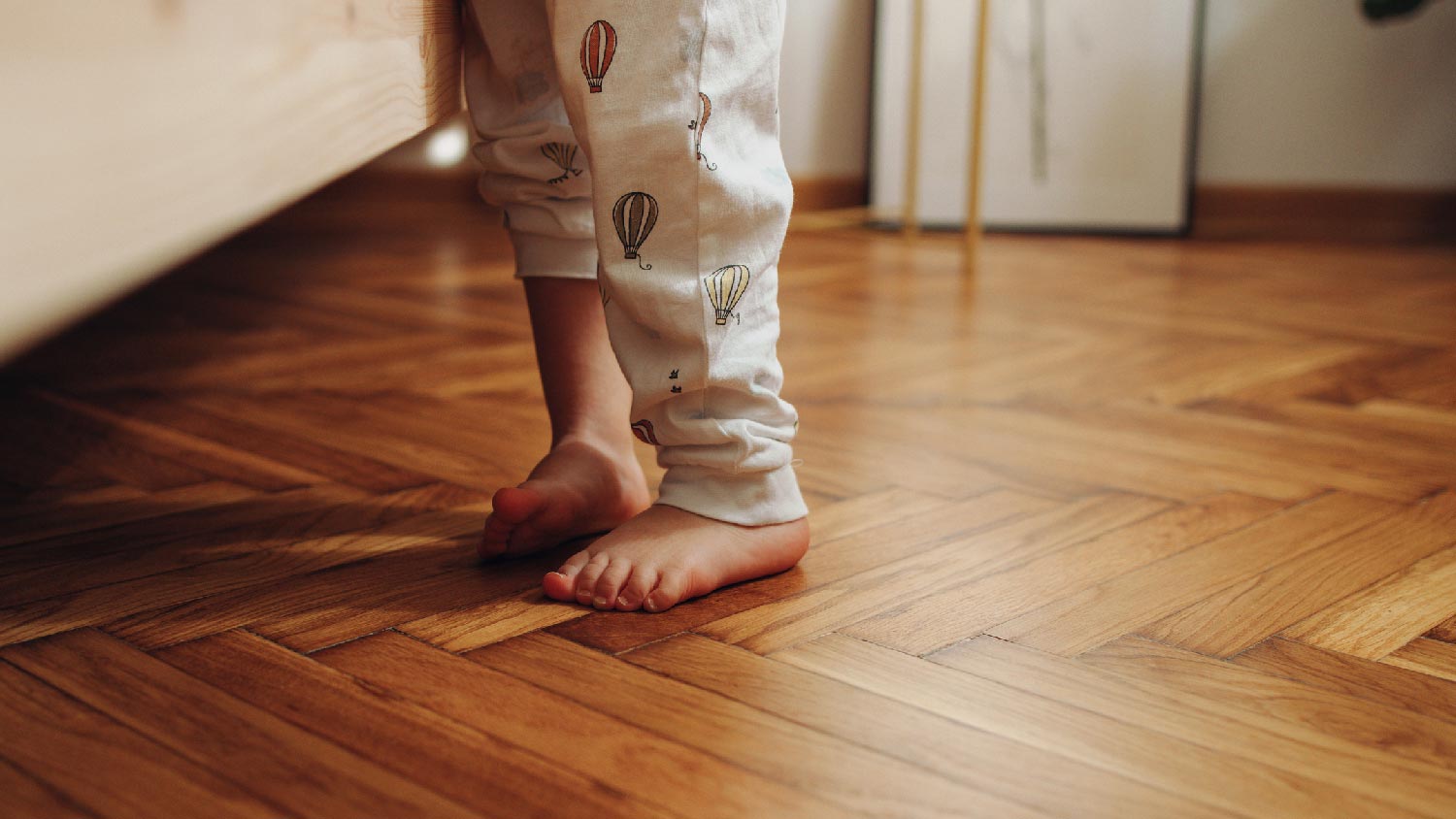
Both materials and labor determine hardwood floor installation costs. This guide breaks down all the prices you need to know before starting your new flooring project.
They may look similar, but one contains real hardwood


Engineered wood flooring contains real wood, while laminate does not.
Engineered wood, at $4 to $7 per square foot, is more expensive than laminate, which costs $1 to $4 per square foot, but engineered wood can add more home value.
Laminate flooring is more durable and easier to maintain than engineered wood.
Neither flooring is entirely waterproof, so you shouldn’t use either one in a full bathroom.
These days, there are approximately a zillion options on the market for homeowners looking to replicate the look of natural hardwood floors without the expense or maintenance. Of those zillion options, two often rise to the forefront for their durability and appearance: engineered wood flooring and laminate planks. In fact, at first glance, these two hardwood alternatives can seem almost indistinguishable. However, (spoiler alert) there are significant differences between them, and understanding those differences can help you make an informed choice about which will work best in your home.
The main difference between engineered wood flooring and laminate is that engineered wood flooring actually contains a top layer of real hardwood, but laminate doesn’t. In engineered hardwood flooring, a layer of natural wood is bonded to a bottom layer (or layers) of plywood or fiberboard. Laminate flooring, on the other hand, is made almost entirely of fiberboard or composite. Manufacturers often include a decorative layer to offer the wood-grain appearance, and they top off the laminate with a protective wear layer or overlay for increased durability.
Of course, this difference in construction leads to other differences—in price, installation process, durability, maintenance requirements, and more. Below, we’ll take a deeper dive into each of these hardwood alternative options so you can figure out which is the winner in your book.

Engineered wood flooring is an alternative to solid hardwood that includes a layer of real hardwood bonded to a sturdier composite underlayer—or several layers of plywood. This construction offers homeowners the best of both worlds: the beauty, authenticity, and increased home value that hardwood flooring can bring with less risk of temperature- or moisture-related warping. Plus, it does all that at a lower overall cost than solid hardwood, which can run from $8 to $20 or more per square foot compared to engineered hardwood’s $4 to $7.
| Pros | Cons |
|---|---|
| Looks and feels like real hardwood | Costlier than laminate at $4 to $7 per square foot |
| Can increase home resale value almost as much as solid hardwood | Even water-resistant options are not fully waterproof |
| More environmentally friendly than many other flooring types | Maintenance can be difficult |
Best for: Homeowners willing to invest upfront (and perform more maintenance) for real wood
Engineered wood flooring contains real hardwood as its top layer. So, from the perspective of people walking on it, it’s pretty much impossible to tell the difference between engineered wood and hardwood flooring (with the exception of the fact that it can actually be a little less noisy—a plus).
Real wood is a high-quality material, and the plywood or composite core underneath it helps make it more durable and resistant to warping. This means that engineered hardwood can increase your home’s value almost as much as solid hardwood can, which is important for those considering selling their homes someday.
While it’s less expensive than solid hardwood, in the face-off against laminate flooring, engineered wood is definitely the higher-cost option. That monetary cost is combined with more effort-intensive maintenance, too. Because hardwood flooring has actual, natural wood grain, dirt can more easily get trapped in its textured surface, making cleaning more difficult. Furthermore, you’ll need to occasionally refinish the wood. Lower-end engineered wood flooring may have a thin enough top layer that you can only do so a few times, decreasing its longevity.
Finally, keep in mind that neither engineered hardwood nor laminate flooring is entirely waterproof, though water-resistant options are available. These flooring choices are not right for full bathrooms, though they may work in a lower-moisture environment, like the kitchen.

Laminate flooring is composed entirely of artificial and manufactured materials. So, while it doesn’t have the authentic feel of hardwood that engineered wood flooring can offer, it does have increased durability, resistance to scratching (great for pet owners), and an easier maintenance process. Plus, at $1 to $4 per square foot, it’s more affordable than engineered wood. To top it all off, because the appearance isn’t limited by naturally occurring wood types, it offers an even wider range of design choices.
| Pros | Cons |
|---|---|
| More affordable than engineered wood | Doesn’t increase home value as much as engineered wood |
| More durable and scratch-resistant | Doesn’t feel as authentic as engineered or solid hardwood |
| Easy to clean and maintain | Even water-resistant options are not fully waterproof |
Best for: Homeowners with pets or kids, high-traffic areas, and budget-conscious remodelers
Given how important cost is for home improvement projects, it’s worth mentioning that laminate flooring is significantly less expensive than engineered wood: $1 to $4 per square foot as opposed to $4 to $7 for engineered wood. (This price is before the cost of labor, which can add $2 to $7 per square foot, depending on the local wood floor installer you choose.)
Along with its lower financial burden, laminate flooring also offers more durability and resistance to scuffs and scratches. That’s especially important for homeowners who have pets or kids running around the house or simply for higher-foot-traffic areas. It’s also extremely easy to clean and maintain throughout its lifetime.
Because laminate flooring is less expensive, it doesn’t increase your home value as much as engineered wood or solid hardwood (though this may matter less for those planning to stay in their homes indefinitely). Plus, laminate simply can’t replicate the look, feel, sound, and step of authentic wood flooring.
Unfortunately, even waterproof laminate flooring is not entirely waterproof. If you’re looking for bathroom flooring, you may want to consider vinyl planks or tile—though waterproofed laminate can stand up to moderate moisture and quickly-mopped-up spills.

Now that we’ve investigated each of these options on its own, let’s put them head to head.
The winner in the “appearance” category is always subjective and dependent on your tastes. However, many people agree that the natural grain and texture of engineered wood wins, even over the wider variety of design choices offered by laminate.
Laminate offers more diversity in design options, plain and simple. Choose any color of the rainbow and chances are, you can find a laminate floor to suit your needs.
Because of its tough overlay, laminate is much more impermeable to scratches, scuffs, and other evidence of day-to-day wear and tear.
Even after the cost of labor, laminate flooring is substantially more cost-effective than engineered hardwood. Engineered wood costs $4 to $7 per square foot, and laminate costs $1 to $4 per square foot. Keep in mind that laminate won’t increase your resale value as much as engineered wood, though.
A professionally installed laminate floor could last as long as 25 years without needing any extensive maintenance. Laminate flooring maintenance mainly means sweeping and mopping regularly. While engineered hardwood can also last 25 to 30 years, it does require occasional refinishing, which is a time-intensive task that’s better left to a pro.
For those hoping to significantly increase their home’s value with a remodel including new flooring, engineered hardwood will go further than laminate—though not as far as solid hardwood can.
From average costs to expert advice, get all the answers you need to get your job done.

Both materials and labor determine hardwood floor installation costs. This guide breaks down all the prices you need to know before starting your new flooring project.

Hardwood floor repair costs depend on the problem. This guide breaks down common costs based on factors like the type of problem, repair method, and whether you hire a pro or DIY.

Here’s what you should expect to pay when renting an orbital, drum, vibrating, or edging floor sander—as well as where you can rent them and what else to know.

You can install hardwood floors over concrete, but you need to prepare the surface properly and install the right vapor barrier.

If you want to avoid hiring a professional to refinish your floors, it can pay to learn how to restore hardwood floors without sanding.

Asking your contractor these laminate, stone, and hardwood floor questions before your flooring project starts can help you prepare.